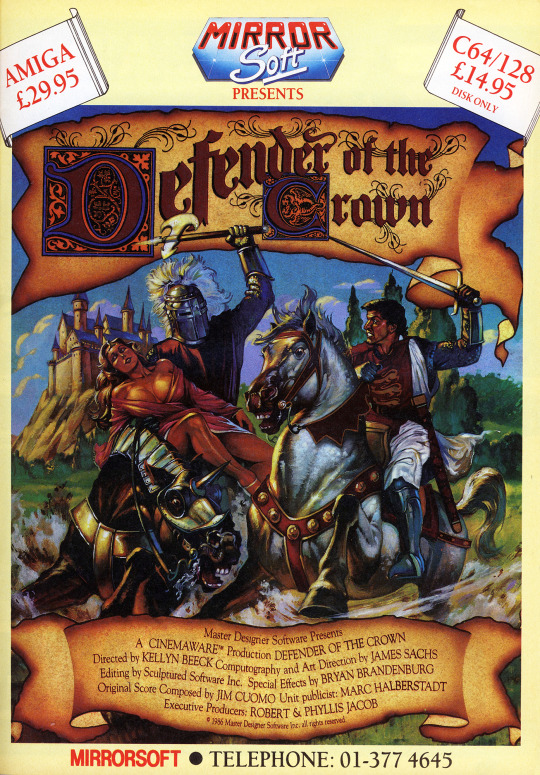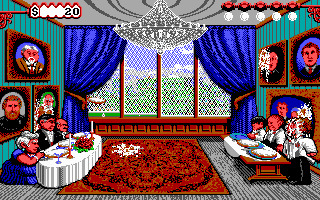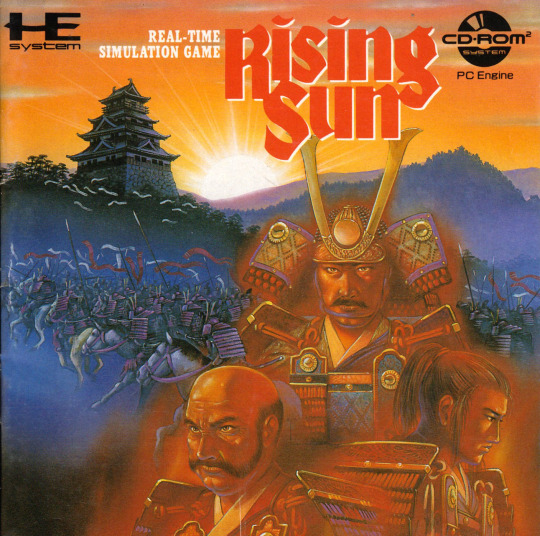#Cinemaware
Explore tagged Tumblr posts
Text

It Came from the Desert (Amiga) (1989)
#it came from the desert#cinemaware#amiga#amiga games#point and click#desert#sunset#videogames#gaming#games#retrogaming#retrogames#arcade#aesthetic#backgrounds#gamebackground#clouds#sky#pixelart#pixelaesthetic#VGArt#80sgames
77 notes
·
View notes
Text

UK 1987
#UK1987#CINEMAWARE#MIRRORSOFT#MASTER DESIGNER SOFTWARE INC.#ADVENTURE#ACTION#STRATEGY#AMIGA#ATARIst#C64#IBM#AMSTRAD#APPLE#MACINTOSH#NES#CDTV#CD I#DEFENDER OF THE CROWN
74 notes
·
View notes
Text


Lethal Weapon 3 (1992)
25 notes
·
View notes
Text

Someone had a bit too much merry last night
2 notes
·
View notes
Text
Retro Gaming Ads Blast – Part 9
Welcome back readers, fellow geeks and electronic gaming fans! In this edition of the Retro Gaming Ads Blast (RGAB) series, we will take a look at another batch of retro gaming print ads from the 1980s and 1990s. For the newcomers reading this, Retro Gaming Ads Blast (RGAB) looks back at the many print ads of games (console, arcade, computer and handheld) that were published in comic books,…

View On WordPress
#1980s#1990s#Acclaim#advert#advertisement#advertisements#advertising#adverts#America#Amiga#amusement#arcade#arcade games#Atari#Atari 2600#basketball#Bayou Billy#Blades of Steel#Blog#blogger#blogging#Capcom#Captain America#Carlo Carrasco#Carnage#Cinemaware#console gaming#consoles#cowboy#cowboys
0 notes
Text

Cinemaware's "SDI" (Strategic Defense Initiative) computer game transports players into the high-stakes arena of Cold War era politics and military strategy, emphasizing the technological race for missile defense systems. Released during a period when the real-world SDI was a prominent aspect of U.S. defense policy, the game provides a unique portal to explore the historical context and implications of this ambitious program. This analysis will delve into the development of the SDI technology, its reception by U.S. government officials, and its portrayal in the game, using insights from historical figures and documents.
During the Reagan administration in the early 1980s, the Strategic Defense Initiative was proposed as a system to prevent missile attacks from the Soviet Union, fundamentally changing the nature of nuclear deterrence. Known popularly as "Star Wars," the initiative aimed to develop ground-based and space-based systems to intercept incoming missiles. "SDI" the game reflects this historical moment by situating players in the role of managing and deploying defense technologies to protect national interests, mirroring the real-world strategic emphasis on technological advancement for national security.
The SDI program represented a significant leap in defense technology, proposing the use of lasers, satellite tracking, and other advanced technologies to intercept missiles before they reached their targets. Figures like President Ronald Reagan and Secretary of Defense Caspar Weinberger were strong advocates of the initiative, arguing that it would provide a fail-safe against nuclear aggression. In the game, this translates to scenarios where players must strategically deploy satellite defenses, manage resources, and respond to threats in real-time, encapsulating the technological and strategic challenges that were debated at the highest levels of government.
While SDI was heralded by some as a visionary approach to missile defense, it also faced substantial criticism both domestically and internationally. Critics argued that the technology was unfeasible and provocatively disruptive to the existing nuclear deterrence strategies. Moreover, the immense costs associated with SDI were a point of contention within Congress and among the American public. The game, through its simulation of managing a national defense system, subtly reflects these tensions, offering players insights into the complexities and pressures of implementing such a monumental defense strategy.
The Strategic Defense Initiative also played a significant role in U.S.-Soviet relations, with the Soviet Union viewing the program as a threat that could undermine the mutual vulnerability upon which MAD (Mutually Assured Destruction) was based. This aspect of international tension is mirrored in "SDI," where players must navigate not only the technical aspects of missile defense but also consider the broader geopolitical implications of their decisions. The game thus serves as a commentary on the delicate balance of power during the Cold War, where technological advancements had the potential to shift international dynamics profoundly.
Cinemaware's "SDI" not only serves as an engaging strategic game but also as a historical reflection on a pivotal era in U.S. defense policy. By exploring the development and controversy surrounding the Strategic Defense Initiative, the game offers players a deeper understanding of the technological ambitions and geopolitical calculations of the 1980s. It provides a unique perspective on how technological innovation can influence global politics and security and invites players to reflect on the enduring implications of America's military strategies during the Cold War. This analysis underscores the game's value in educating and engaging with historical military and political strategies through interactive media.
0 notes
Text
youtube
🎮 It Came from the Desert (TurboGrafx-CD)
Complete Gameplay: https://youtu.be/WkGmqcKFHVM
#ItCameFromTheDesert #Cinemaware #NEC #TurboGrafx16 #PcEngine #TurboGrafx #Commodore #PcEngineCD #Amiga #TurboGrafxCD #CdRom2 #FMV #エスパー防衛隊 #エヌイーシー #ピーシーエンジン #Viciogame #Gameplay #Walkthrough #Playthrough #Longplay #LetsPlay #Game #Videogames #Games
#It Came From The Desert#Cinemaware#NEC#TurboGrafx-16#Pc Engine#TurboGrafx#Commodore#Pc Engine CD#Amiga#TurboGrafx CD#Cd-Rom²#FMV#エスパー防衛隊#エヌイーシー#ピーシーエンジン#Viciogame#Gameplay#Walkthrough#Playthrough#Longplay#Let's Play#Game#Videogames#Games#Youtube
1 note
·
View note
Text
The Three Stooges (DOS/C64, Cinemaware & Incredible Technologies, 1987/1988)
You can play this minigame-fest in your browser here (DOS version) or here (C64 version).
C64 controls may include function keys and/or numpad 84620.







#internet archive#in-browser#dos#dos games#c64#commodore 64#game#games#video game#video games#videogame#videogames#computer game#computer games#licensed games#three stooges#the three stooges#3 stooges#the 3 stooges#retro games#retro gaming#retro graphics#1987#1988#1980s#80s
7 notes
·
View notes
Text
PC Engine - Lords of the Rising Sun
Title: Lords of the Rising Sun / ライジング・サン
Developer: Cinemaware Corporation / Aprinet / A Wave
Publisher: Victor Musical Industries
Release date: 13 March 1992
Catalogue No.: JCCD2006
Genre: Historical Simulation
Format: CD-ROM2


Cinemaware tries to take on Koei with their very own ancient Japan-based strategy game, taking on Koei's Nobunaga no Yabou series which, just like this one, also has an Amiga version. Lords of the Rising Sun sure has a lot of Amiga roots. This one saw a Sharp X68000 port, as well as a port to the Philips CD-i. As far as looks go there are some nice presentation screens as well as a clean graphical interface, so all is good in the looks department. The main problem with this title is that it's just too slow. Loading takes quite some time which, to be honest, was a joke. This is a PC Engine CD, not an Amiga.
Saying that though, I guess if you're a fan of these types of games long loading times may not bother you so much due to the slow-paced nature of these games in the first place. Another thing that dooms this game is that you need a Ten no Koe Bank memory card on hand to save any game data since the saves are far too big to save to the limited internal memory. This is not such a great idea because we all know how small the internal memory is.
A nice attempt and for all I know Lords of the Rising Sun could be a very good game if I gave it more time but from what I’ve seen I'd have to recommend going with one of the many Koei efforts rather than this.






youtube
youtube
2 notes
·
View notes
Text
It Came From The Desert - lost conversions for Atari ST, C64 and SEGA Mega Drive
It Came From The Desert was a classic Cinemaware title that was also due for release on the #AtariST, #Commodore64 and #SEGA Mega Drive platforms. None of them saw release, though thankfully the SEGA edition did sneak out in later years.
Read more at:
https://www.gamesthatwerent.com/2024/10/it-came-from-the-desert/
#unreleased#retro#prototype#gtw#commodore#c64#lost games#unreleased games#cancelled games#atarist#sega mega drive
0 notes
Text
It’s such a coincidence that this came across my dash this morning; I was looking up Cinemaware software earlier this week, and remembered playing this on my Amiga way back in the last century (literally). At the time, I remember being enthralled with this game, and spending hours on it. Then, I looked up some gameplay on YouTube, and I’d forgotten how . . . different it was. Alright, slow. It was slow, and tedious. But at the time - amazing! I’ll throw the video in, too:
youtube

163 notes
·
View notes
Text

27 notes
·
View notes
Text

UK 1987
#UK1987#MIRRORSOFT#CINEMAWARE#MASTER DESIGNER SOFTWARE INC.#ICOM SIMULATIONS INC.#ADVENTURE#ACTION#STRATEGY#C64#AMIGA#IBM#ATARIst#APPLE#MACINTOSH#MSX#PC 98#PC 88#NES#AMSTRAD#CD I#CDTV#DEFENDER OF THE CROWN#S.D.I.#DEJA VU#UNINVITED#BALANCE OF POWER#SINBAD AND THE THRONE OF THE FALCON
14 notes
·
View notes
Text

The King of Chicago (Macintosh), 1986.
#abandonware#gaming#video games#retro games#80s#crime#vaporwave#retrowave#aesthetic#pixel art#master designer software#cinemaware
124 notes
·
View notes
Photo









Defender of the Crown, Amiga (1986)
Defender of the Crown II, Amiga (1992)
#defender of the crown#cinemaware#amiga#retrogaming#video game#videogame#80's#1980s#80s#1986#90's#90s#1990s#1992
415 notes
·
View notes
Text

Cinemaware's 'Defenders of the Crown' is a historically themed strategy game set in medieval England, where players vie for control against rival factions to unify the nation under their rule. Alongside its strategic gameplay and historical narrative, the game became notable for its advertising, which, like many video games of its era, featured sexualized imagery of female characters.
This marketing strategy can be explored through the lenses of various philosophical theories including feminist theory, psychoanalytic theory, and the philosophy of art and aesthetics. These perspectives will help unpack the implications of such advertising and its broader cultural impact.
1. Feminist Theory and the Objectification of Women: The feminist philosopher Simone de Beauvoir provides a crucial framework for analyzing the sexualization in the game's advertising. In her seminal work, "The Second Sex," Beauvoir discusses how women have historically been depicted as 'the Other,' an alterity defined in opposition to the male subject. The portrayal of women in 'Defenders of the Crown' advertising as objects of visual pleasure for a presumed male audience exemplifies this concept. The game’s advertising uses the female form as a decorative element to attract attention, which can be seen as a reduction of female agency and subjectivity, reinforcing gender stereotypes.
2. Psychoanalytic Perspectives on Visual Pleasure: Building on feminist film theory, particularly Laura Mulvey's concept of the "male gaze," the advertising can be analyzed through a psychoanalytic lens. Mulvey argued that in cinema, women are often styled to cater to male viewing pleasure, a phenomenon that can be extended to video game advertising. This perspective suggests that the sexualized portrayal of women in the game's marketing not only reflects but also perpetuates patriarchal views where women’s value is predominantly assessed through their physical appearance and sexual desirability.
3. Hegelian Dialectics of Master-Slave in Media Consumption: Georg Wilhelm Friedrich Hegel’s dialectic of master-slave can be applied to understand the dynamics between the viewer (consumer) and the viewed (advertising content). In this context, the consumer is posited as the 'master' who imposes his subjective view on the 'slave,' the advertising content, which is objectified and deprived of autonomy. This dynamic is complicated by the consumer’s dependency on the content for gratification, which subtly shifts power dynamics.
4. Jean Baudrillard and the Hyperreality of Advertising: Jean Baudrillard’s concept of hyperreality, where the distinction between reality and simulation blurs, is relevant to the portrayal of women in video game advertising. Baudrillard suggests that in a media-saturated culture, simulations do not merely represent reality—they become more real than reality itself. The idealized, sexualized images of women in 'Defenders of the Crown' advertising could be seen as hyperreal, influencing and distorting consumer expectations and perceptions of real women.
5. The Aesthetics of Representation and Its Ethical Implications: Arthur Danto’s philosophy of art and representation highlights the ethical implications of how subjects are portrayed in media. Danto argued that artworks contribute to the formation of societal narratives and values. Thus, the aesthetic choices made in video game advertising are not merely commercial—they are ethical decisions that shape societal attitudes towards gender and sexuality.
In conclusion, the advertising of 'Defenders of the Crown' serves as a case study for understanding the intersection of media, culture, and gender dynamics. By applying feminist, psychoanalytic, Hegelian, Baudrillardian, and aesthetic theories, we gain a deeper insight into how such advertising reflects and reinforces cultural norms and values, raising questions about the role of media in shaping and perpetuating gender stereotypes in society."
1 note
·
View note